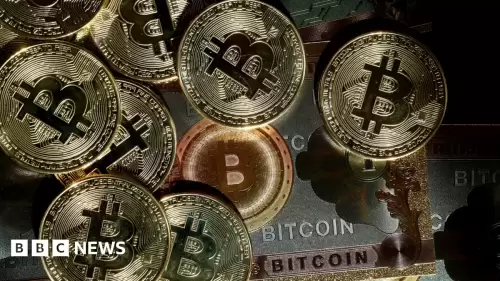 |
|
 |
|
 |
|
 |
|
 |
|
 |
|
 |
|
 |
|
 |
|
 |
|
 |
|
 |
|
 |
|
 |
|
 |
|
Cryptocurrency News Articles
Automated Market Makers (AMMs) Explained: How They Work and Why They're Important
May 21, 2025 at 05:12 am
In the world of cryptocurrency and decentralized finance (DeFi), many of the most important concepts that you need to understand can seem overwhelmingly complex. One innovation that has significantly simplified trading on decentralized exchanges is the Automated Market Maker (AMM).

In the rapidly evolving world of cryptocurrency and decentralized finance (DeFi), many of the most important concepts that you need to understand can seem overwhelmingly complex. However, some innovations in the industry have significantly simplified trading on decentralized exchanges.
One such innovation is the Automated Market Maker (AMM). An AMM doesn’t rely on traditional order books like centralized intermediaries do. Instead, it allows users to trade digital assets directly with each other using smart contracts. But how do AMMS work exactly, and why are they so important in the crypto ecosystem? Let’s break it down.
What Is an Automated Market Maker?
An Automated Market Maker (AMM) is a protocol that facilitates the buying and selling of assets on a decentralized exchange (DEX) without the need for a centralized order book. Simply put, it’s a system that relies on algorithms to automatically set the asset prices based on supply and demand.
AMMs use liquidity pools, which are pools of tokens provided by users (or liquidity providers) to enable easier trading. When someone trades on an AMM, the transaction is executed directly with the liquidity pool rather than by matching buyers and sellers, as is common in traditional financial markets.
Popular DEXs powered by AMMs, such as Uniswap, SushiSwap, and Curve Finance, have changed how we trade tokens and other digital assets. These tools give users more control and more transparency when making transactions.
To help visualize how this works, here is a simple diagram from Uniswap’s docs, the most popular AMM-powered DEX, showing how tokens flow in and out of liquidity pools during a trade:
How Automated Market Makers Work
Automated Market Makers (AMMs) alter the way people trade crypto by replacing order books with smart contracts and liquidity pools. Let’s take a closer look at how they actually function.
No Buyers and Sellers – Only Liquidity Pools
On traditional exchanges, you always need someone else on the other side of the trade. Automated Market Makers do away with this system. They don’t match buyers and sellers but instead use collections of tokens locked in smart contracts, famously known as liquidity pools.
Let’s say that you want to trade ETH for USDC on Uniswap. You aren’t buying from a trader who has these coins and wishes to sell them. Instead, you are trading with a smart contract that holds a pool of both assets. The smart contract uses a formula to determine how much you will get in return for your trade on the platform.
The Constant Product Market Makers
At the heart of most AMMs is a simple yet powerful model known as a constant product market maker. The model uses this formula:
X × Y = K
Here is an example of how the AMM adjusts prices automatically depending on how much is in the liquidity pool:
Imagine a liquidity pool with 10 ETH and 20,000 USDC. The AMM would plug these figures into the equation like so:
10 x 20,000 = 200,000
The result would be K = 200,000. If you decide to add 1 ETH to the pool and take out USDC instead, the new ETH balance would become 11. To keep K constant at 200,000, the pool must reduce the USDC by a specific amount. So now you have:
11 x Y = 200,000
Y = 18,181.81 USDC (approximately)
In the end, assuming the AMM calculates everything correctly, you would receive 20,000 – 18,181.81 = 1,818.19 USDC for your 1 ETH.
Constant Product Market Maker vs. Constant Sum Market Maker
Some protocols, especially early or experimental ones, have used what we call a constant sum market maker model. These use a simpler formula:
X + Y = K
This model keeps the total value of tokens constant, not the product. However, the model is avoided by major exchanges. It can be useful in certain low-volatility scenarios like stablecoin swaps, but constant sum market makers can actually run into major problems if one of the tokens in the liquidity pool runs out. Arbitrageurs could drain the pool completely at no cost.
That’s why the constant product model, used by Uniswap, PancakeSwap, and other DEXs, is considered much more robust. It guarantees liquidity at any price, even if the prices become extreme.
Bigger Liquidity Pools = Better Prices
Generally, the more tokens in a liquidity pool, the smaller the price impact when you make your trade. This price impact is called slippage. In a smaller liquidity pool, a big trade can make a major shift in the price.
You can see why that happens if you plug a large transaction into a small pool’s constant product
Disclaimer:info@kdj.com
The information provided is not trading advice. kdj.com does not assume any responsibility for any investments made based on the information provided in this article. Cryptocurrencies are highly volatile and it is highly recommended that you invest with caution after thorough research!
If you believe that the content used on this website infringes your copyright, please contact us immediately (info@kdj.com) and we will delete it promptly.





























































